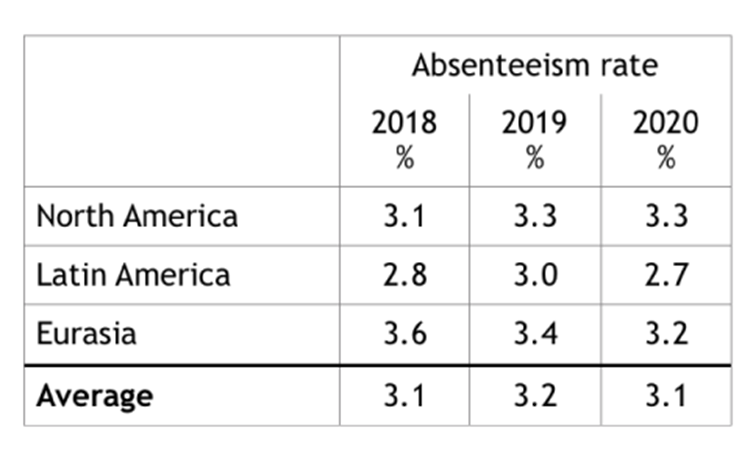In any business, employee absenteeism is a costly problem. If high numbers of employees are regularly absent, it can lead to decreased productivity, low morale, and even financial problems. But what if there was a way to use absence rate data to help reduce employee absenteeism? In this blog post, we’ll explore how businesses can use absence rate data to identify and address the causes of employee absenteeism. We’ll also look at some tips for reducing absences and improving productivity. Stay tuned!
What Is Absence Rate?
Absence rate is a metric that measures how often people in your company have unplanned time off due to sickness or other causes. It can be measured for an individual, team, or whole business, and each figure gives you an insight into how healthy your organization is.
A high absence rate might indicate a lack of employee engagement, which can affect productivity. Additionally, absenteeism can be caused by poor working conditions or job satisfaction.
As such, it’s important to investigate the reasons behind a high absence rate to address the root of the problem. Improving attendance can have a positive ripple effect on other business areas, so it’s worth taking the time to ensure that your employees are happy and healthy.
Why Is It Important For Businesses To Track Their Absence Rate?
Several vital reasons businesses should track their employees’ absence rate. First, absenteeism can indicate underlying issues, such as poor health or job dissatisfaction. By tracking absences, employers can identify patterns and take steps to address the root causes of the problem.
Second, absenteeism can have a significant financial impact on businesses. The costs of lost productivity, replacement workers, and missed sales opportunities can add up quickly.
Finally, absenteeism can damage morale and cause stress for other employees who have to pick up the slack. By tracking absences and taking steps to address the problem, businesses can improve their bottom line and create a healthier, more productive workplace.
How Do You Calculate the Absence Rate?
You’ll need to take a few steps to calculate your company’s absence rate. First, you’ll need to determine the total number of working days. This can be done by taking the total number of days in the year and subtracting weekends, holidays, and any other days when employees are not expected to be at work. Once you have that number, you’ll need to divide it by the total number of days absent. This will give you your company’s absence rate.
Here’s the formula:

Different Ways Of Absence Rate Calculation
Individual Basis
Individual absence rate is calculated by dividing the total number of days absent from work for a single employee over some time, divided by the total number of available working days. For instance, if an employee took ten days of leave in a year and the total number of working days was 240, then the individual absence rate would be 4.2%.
Group Basis
The group absence rate is calculated by summing up the number of days absent from work for a group of employees over some time, divided by the total number of available working days. For example, if ten employees in a team took 100 days off from work in one year and the total number of working days was 2400, then the group absence rate would be 4.17%.
Company Basis
Company absence rate is measured by finding the average individual and group absence rates within a company. It is calculated by dividing the total number of days absent from work by the total number of available working days across all employees in that organization. For example, if a company has 500 employees and they took 3000 days off from work in one year and the total number of working days was 48000, then the company absence rate would be approximately 6.25%.
Absence rates can be used to compare the productivity of different companies or to track changes in employee attendance over time. Understanding your organization’s absence rate is a key part of managing costs and creating a positive work environment for employees.
Factors That Affect Absence Rate
Absenteeism in the workplace can be caused by various factors, ranging from personal issues to workplace policies. Here are some common contributors to a high absence rate:
Health and Safety Issues:
Poor health and safety regulations or hazardous work conditions can lead to increased absences, especially when employees feel unsafe or uncomfortable in their job environment.
Time-Off Policies:
An organization’s policies and procedures regarding vacation, sick days, personal business requests, and other types of time off can all affect the absenteeism rate. When there are limited or no policies in place that allow employees to take time off for legitimate reasons, it can lead to an increase in absences.
Work-Life Balance:
Many employers are now offering more benefits, such as flexible working hours and telecommuting, that help employees maintain a healthy work-life balance. When these options aren’t available, it can lead to increased stress and burnout, resulting in higher rates of absenteeism.
Cultural Differences:
Every organization has its own unique culture and values, and employees must align with these to be more likely to follow the rules and take their job seriously. Employers need to consider cultural differences when creating policies and procedures that affect attendance.
High Turnover Rate:
A high turnover rate can lead to increased absenteeism due to the lack of stability within an organization. When employees constantly leave, and new hires have to be trained, it can distract from the workday and lead to higher rates of absenteeism.
These are just a few factors that can affect an organization’s absenteeism rate. To reduce absenteeism, employers should consider implementing policies and procedures encouraging attendance, such as offering flexible hours or financial incentives for showing up on time.
What Is A Good Absence Rate?
To have a good absenteeism rate, you should aim for 1.5%. This is because the average rate is 1.8%. A healthy absenteeism rate will help ensure that your employees are present and accounted for. It will also help reduce the amount of time your employees are away from work. When your employees are present and working, they can be productive and contribute to the company. Therefore, a reasonable absenteeism rate is essential to have a successful business.
What Is A Bad Absence Rate?
A rate above 4% may be deemed a high absence rate by some employers. For every 100 employees, four or more are absent on any given day. While there will always be some absences that are out of your control, if you have too many employees with a bad absence rate, it can start to affect your bottom line. There are a few things you can do to help improve the situation, such as offering incentives for attendance, instituting strict policies around calling in sick, and offering more flexible work arrangements. But at the end of the day, it’s up to each employee to make an effort to be there when they’re needed.
Example Absence Rate
Various teams, departments, or geographical areas can break down absenteeism rates. This allows for greater clarity on which areas of the organization have higher rates of absence and suggests opportunities for targeted interventions.
Let’s look at the example given below:

Organizations may track various metrics in their absence reporting, such as frequency of absences, average absence duration in days, zero absence rate, number of instances of absence, and number of times an employee has ended an absence. An example of a 2019 absenteeism report is provided below to illustrate how these metrics can be tracked.

Strategies To Decrease The Absence Rate
Establish clear expectations:
Ensure employees understand what is expected of them in terms of attendance and punctuality. Develop a written policy or code of conduct outlining the consequences for unacceptable absences and tardiness, including potential disciplinary action if necessary.
Award attendance:
Recognize and reward employees who have strong attendance records. This can be done through incentives such as extra paid time off, gift cards, or other rewards that are meaningful to the employee.
Encourage open communication:
Allow employees to speak freely and openly about their attendance concerns or issues they face to understand better why absences may occur. Encouraging this dialogue between staff and management can help identify potential solutions to the issues they’re facing and improve the overall attendance rate of your team.
Provide flexible scheduling options:
Offering flextime or remote work options can be a great way to reduce absences and increase job satisfaction. Providing employees with more flexibility in their schedules gives them more control over their lives, which can help them better manage any conflicts between work and personal commitments.
Address underlying causes:
If an employee is consistently absent or tardy, it may be a sign of a larger issue, such as burnout or poor job satisfaction. By addressing these issues head-on, you can identify potential solutions that will make employees happier and more productive in the long-term.
Stay consistent:
Implementing an attendance policy is only effective if it is consistently enforced. Ensure all staff members are aware of the policy and held to the same standards regarding absences or tardiness. Even small changes, such as issuing warnings or providing additional training, can effectively improve your team attendance.
The key to successfully decreasing absenteeism and improving attendance is to foster an environment that encourages open communication and offers flexible scheduling options. By implementing a comprehensive plan with clear expectations, rewards for solid attendance, and consistent policy enforcement, you can create a workplace culture where employees prioritize their attendance and feel supported.
Conclusion
Reducing employee absenteeism can be a daunting task, but using the absence rate is one tool that may help you. The important thing to remember is to focus on the underlying reasons for why employees are absent and address those issues directly.

